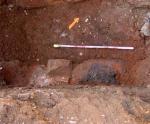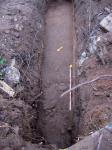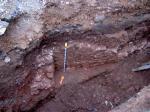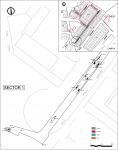Summary (English)
Research (November 2007 – January 2008)
The sanitation renovation carried out by the town hall of Mérida on Poeta Marcial Street located on a 20th century expansion of the town and within Protection Area 3 of the land-use plan ( PGOU in Spanish) is presented in this section. The plot is located outside to the Roman town, very close to the Circus. Compared to bordering streets, Poeta Marcial Street has an artificial terracing and a strong slope northeast. Previous excavations confirmed that the plot comprises several roads from the early Roman occupation.
The oldest remains were found on the use level (UE 19) and the pavement level (UE 20) of a road that might have been found previously. Even though the section found is too small to locate properly, we might have found Via 7 of the emeritenses roads (Sánchez y Marín, 2000).
The road may join two areas where different funerary activities were carried out (A4-A7). The first area contains the remains of a cremation grave (UUEE 7-8); post- depositional mortuary remains on the filling of the grave date it back to 1st century AD or early 2nd century AD.Marking out the probable line of the road the remains of two funerary buildings (A6-A7) were found. In the first building, we found a cremation grave with remains of a post-depositional burial from the 2nd half of the 1st century A.D. -to the 1st half of the 2nd century A.D. In the second building, remains only of western and northern side enclosure walls were found. Since there are lots of funerary structures in Disco, we can assume that it is a polygonal funerary building.
We can conclude, from all the information that was collected, that our results confirm that Disco was a burial area for the two first centuries AD. When it went out of use, there was no occupation until the area was developed in the 20th century and early 21st century. At that time the street was paved and drains created so that the latest remains found in the excavation belong to the sanitation set up and street cobbling.
- Pedro A. Delgado Molina
Director
- Pedro A. Delgado Molina
Team
- Marcos Aza
- Javier Pacheco
- Javier Montero Liberal
Research Body
- Consorcio Ciudad Monumental de Mérida
Funding Body
- Maire S.L.





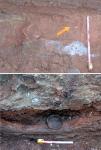
![Download [PDF]](/excavation/skins/fasti/images/results/download_sml.png)
